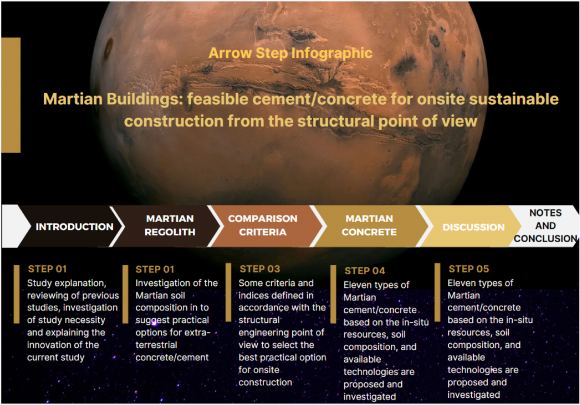Imagine you’ve just gotten to Mars as part of the first contingent of settlers. Your first challenge: build a long-term habitat using local materials. Those might include water from the polar caps mixed with specific surface soils. They might even require some very personal contributions—your blood, sweat, and tears. Using such in situ materials is the challenge a team of Iranian engineers studied in a research project looking at local materials on Mars.
In situ resource utilization has always been part of Mars mission and colonization scenarios. It’s expensive to bring along habitat construction materials with you, and space will be limited onboard the ship. Once you settle on Mars, you can use your ship as a habitat until you build your new colony. But, what are you going to create new homes from?
Cement or concrete come to mind, made from whatever’s available on or just below the surface. The authors of the study, Omid Karimzade Soureshjani, Ali Massumi, and Gholmreza Nouri, focused on Martian cement. They assembled data sets about soil composition from Mars landers and orbiters and came up with a collection of concrete types that future colonists could use. Next, they applied structural engineering principles and suggested some options for onsite construction using what are called spider/radar diagrams and charts. These allow building planners to apply data for different concepts of Mars architecture.
Building That Mars City
The authors, like most of us, foresee permanent settlements in the next decades. They write, “The goal would be to establish a self-sustaining city (self-sufficient megabase) on the surface of Mars, accommodating at least a million people. However, constructing safe, stable, and sufficient buildings that can withstand the harsh Martian environment for such a population will be challenging. Due to the high costs associated with importing buildings, materials, and structural elements from Earth, it is necessary to construct all buildings on-site using local resources.”
Let’s look at the usability and cost-effectiveness of Martian soil (regolith). Chemically, it’s rich in the right amounts of elements to make different types of concrete. Of course, not all the regoliths are equally useful, so they propose surface scans to find the best surface materials mixes. Presumably, those scans will help future inhabitants find the best collections. Access to those raw materials from around the planet should make them cost-effective, eventually.
Challenges to Mars Construction
Of course, there are other factors besides material availability at work in such a construction project. Here on Earth, we have centuries of experience building in this gravity well, with familiar materials. We know how to build things under this atmospheric pressure, and we don’t have to contend with the harsh conditions of a planet constantly bombarded by ultraviolet radiation. Mars presents the challenge of creating buildings that have to withstand that radiation, the lower atmospheric pressure, and water scarcity. That lower pressure and gravity on Mars could seriously affect the durability of a given concrete made from Martian materials.
In addition to planetary geology and surface conditions, it takes energy to collect, process, and create the building materials needed for long-term habitation. You need a simple, cost-effective energy source—particularly in the beginning. It’s not likely that nuclear power plants will be first on the list to build. Those require a tremendous number of resources. Perhaps later they can be built, but not in the first wave. Solar energy is going to be the “go-to” resource in the beginning. In addition, to make cement, you need water. And, water is a notably scarce resource on much of Mars, except at the poles. They could provide some water from the ice caps, but you’ll likely want to figure out a way to make good cement with the least amount of water.
Using Organic Binders for Mars Home Building Blocks
Interestingly, the authors mention something called “blood concrete”, or its modern version: AstroCrete. It’s a concept based on ancient Roman practices of using organic additives to construction materials (think: animal blood, urine, etc.). Now, they aren’t suggesting that future Martians must “bleed for their art” but our bodies do make plasma rather easily. It could be a useful resource.
A substance called “human serum albumin” (HAS) is under study as a binder to mix with “AstroCrete” materials, along with sweat, tears, and urine. All those will be available in relative abundance in future Mars settlements. The AstroCrete made from Martian soils and human “contributions” is a strong building material you can rely on for strength (and you hope it won’t smell too bad). Essentially, AstroCrete is waterless cement.

Exploring the Possibilities
The authors studied 11 types of cement, including geopolymer and magnesium silica mixtures, all of which require specific materials. They point out that sulfur concrete is probably going to be the most promising avenue for structures on Mars. Others will take more study and implementation to understand their usability in Martian conditions. In the long term, searching out and understanding the materials available on the Red Planet will help future colonists build the necessary habitats and cities. Finally, the authors point out that additional study of both materials and the Martian environment using data from current and future missions is necessary. Their paper is well worth reading in more detail.
For More Information
Martian Buildings: Feasible Cement/concrete for Onsite Sustainable Construction from the Structural Point of View
Martian Concrete Could be Tough Stuff
Blood, Sweat, and Tears: Extraterrestrial Regolith Biocomposites with in vivo Binders
Read our previous article: ‘Dune: Prophecy’ ‘In Blood, Truth:’ Tula plays Frankenstein and Desmond’s twisted origins exposed
